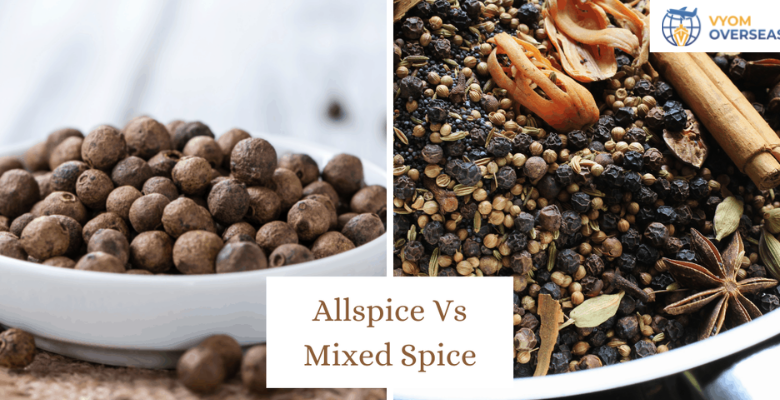Difference Between Allspice and Mixed Spice

Winter is around the corner, and we think it is the best time to discuss two of the most warming spices – allspice and mixed spice. These are some common condiments you will find in wholesale spices suppliers’ catalogues. Often mistaken as the same because of their connotation, but actually mixed spice and allspice are very different condiments. The confusion is apparent as both spices have almost the same aroma.
However, there is a vast difference between the two spices, not just in ingredients but in how and in what dishes they can be used. To give you a clear picture, we have explained what these spices are, which one is better to use, how to make them at home, and also the benefits they offer.
Allspice vs Mixed Spice
Let’s start with the basic difference. Contrary to popular assumption, allspice is not a powder of all the spices. Instead, it is only one spice from a berry called Jamaica pepper. However, mixed spice is actually a blend of several spices and has a milder and sweeter flavour than allspice.
What is Allspice?
Allspice, as opposed to “all” in its name, is made of a single spice. Allspice is a powder of pimento dioic berry, more commonly known as Jamaica pepper. This berry is native to the Caribbean and Central America. When Spanish people were on the lookout for the sea route of India to find black pepper, they reached America and found this spice instead.
It is harvested unripe and dried to make a powder, and this practice gives this spice its distinctive flavour. Although allspice is sweeter, it contains spicy, wood-like undertones. It has a potent aroma and smells like a mix of cloves, cinnamon, and nutmeg, which might be why people confuse it with a mix of spices.
Allspice is more common in savory dishes. It is from Central America and goes perfectly with Mexican and other Central and South American dishes. It is more popular in tagine blends, jerk mixes, curry powders, and seasoning for spicy meat recipes.
What is Mixed Spice?
Mixed spice is exactly what its name suggests. It is a blend of several spices. These spices include cinnamon, caraway, nutmeg, cloves, coriander, and dried ground ginger. These spices are not combined in a 1:1 ratio as cloves and nutmeg are very aromatic and can overpower the condiment with their extreme aroma. Instead, a 90% spice blend is made from cinnamon and coriander, and all the other spices are blended in a 10% ratio.
Unlike allspice, mixed spice is more warm and sweet, with a subtle spiciness and woody flavour. Because of this, mixed spices are more commonly used in sweet treats like puddings, cakes, and biscuits. However, this does not mean they aren’t suitable for savory dishes. On the contrary, these spice mixes can go perfectly well with spicy delicacies. One thing to get attention on is that mixed spice should never be substituted for allspice, as potency and flavour vary drastically.
Which is better?
Allspice and mixed spice both are equally flavorful and useful. Using them depends on the dish or cuisine you are trying to make. As a rule of thumb, allspice should be used in savory dishes as it can elevate the aroma of such dishes. Caribbean, Moroccan, and Indian cuisine can benefit from this spice.
Mixed spices go well with sweet dishes. The sweeter and warmer flavour gives winter sweeties the right flavour people crave for. However, this is not to say that it can’t be used in spicy dishes. In fact, this condiment contains all the common spices that go into Indian cooking, so it can sometimes substitute some of the spices of garam masala blends.
How to make these spices at home?
One of the best ways to acquire these spices is to buy from one of those Indian spices exporters. But if you have the time, energy, and resources to make a fresh batch of these spices, then why not? Go ahead. To make an allspice blend, you will have to procure pimento dioic or Jamaica pepper from the spice market and blend them up to a fine powder, and your allspice powder is ready.
Making mixed spice powder takes little more than blending. To make this condiment, you must take all the spices in proportion and blend them. Here are exact measurements of all the ingredients:
- Ground cinnamon – 4 teaspoon
- Ground coriander – 4 teaspoon
- Caraway – ½ teaspoon
- Ground nutmeg – ½ teaspoon
- Ground cloves – ¼ teaspoon
- Ground ginger – ¼ teaspoon
What are the benefits of these spices?
Both allspice and mixed spice have incredible health benefits, and adding them to your diet help improve your health in many ways. For example, Pimento berries, used to make allspice, have anti-inflammatory properties, aid digestion, and boost the immune system. Moreover, cinnamon in mixed spices lowers blood sugar, ginger cures indigestion, and caraway provides minerals.
Conclusion
Hope this article has helped you know the difference between allspice and mixed spice. Often mistaken as the same, these spices are different in many ways. Now that you know the difference, you can use the right spice blend in your dishes and delight your taste buds with delicious delicacies.




